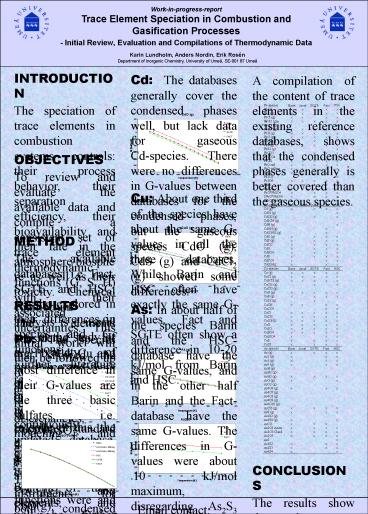Ingen bildrubrik - PowerPoint PPT Presentation
1 / 1
Title:
Ingen bildrubrik
Description:
Initial Review, Evaluation and Compilations of Thermodynamic Data. METHOD ... A compilation of the content of trace elements in the existing reference ... – PowerPoint PPT presentation
Number of Views:19
Avg rating:3.0/5.0
Title: Ingen bildrubrik
1
Work-in-progress-report Trace Element Speciation
in Combustion and Gasification Processes -
Initial Review, Evaluation and Compilations of
Thermodynamic Data
Karin Lundholm, Anders Nordin, Erik
Rosén Department of Inorganic Chemistry,
University of Umeå, SE-901 87 Umeå
INTRODUCTION The speciation of trace elements in
combustion systems controls their process
behavior, their separation efficiency, their
bioavailability and their fate in the
atmosphere/biosphere as well as their toxicity.
Chemical equilibrium analysis is a useful tool in
the study of a variety of processes and there are
several different programs and databases
available. In spite of this, the existing
reference databases vary considerably in content
of trace elements, and possibly quality of data
as well.
Cd The databases generally cover the condensed
phases well, but lack data for gaseous
Cd-species. There were no differences in G-values
between databases for the condensed phases, but
the gaseous species CdO (g), CdS (g) and CdCl2
(g) showed some differences.
A compilation of the content of trace elements in
the existing reference databases, shows that the
condensed phases generally is better covered than
the gaseous species.
- OBJECTIVES
- To review and evaluate the available data and
compile a consistent set of trace element
thermodynamic functions (G, S, H) with their
associated uncertainties. This initial work will
then be followed up by more careful analysis of
the reasons for the discrepancies, modeling and
experimental validation work. The latter using
instruments for both condensed phases (XRD, XPS
and XAFS) and gas species (MBMS). The present
work-in-progress report compiles the existing
data and illustrates some of the most important
uncertainties identified.
Cu About one third of the species have about the
same G-values in all the three databases. While
Barin and HSC often have exactly the same
G-values, Fact and SGTE often show a difference
in 10-20 kJ/mol from Barin and HSC.
METHOD The available databases, i.e. Fact, SGTE
and HSC, was be explored in their differences in
species and G-functions. Further, literature
reviews will be performed to add new data to a
continuously updated database. Given inaccuracies
in H, S and resulting G-functions were and will
be further estimated and tabulated for future
sensibility analysis work and validation.
RESULTS The elements considered so far are Pb,
Cd, Cu and As. For comparison of databases,
G-values from Barin and calculated standard
deviations from Janaf were used.
As In about half of the species Barin and the
HSC-database have the same G-values, and in the
other half Barin and the Fact-database have the
same G-values. The differences in G-values were
about 10 kJ/mol maximum, disregarding As2S3 and
As2S2, which differed of about 100 kJ/mol.
Pb The species that showed the most difference
in their G-values are the three basic sulfates,
i.e. PbOPbSO4, 2PbOPbSO4, 4PbOPbSO4, and also
PbSO4(s), PbCl4(g) and PbO(g).
CONCLUSIONS The results show that there are
significant differences of the commercially
availably databases for Pb, Cd, Cu and As.
Email contact karin.lundholm_at_chem.umu.se































